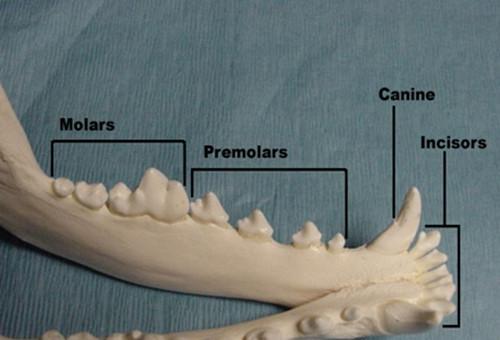With the improvement of parents' understanding of the disease, the dental diseases of their pets are increasingly valued by parents. Then understanding basic dental knowledge and communicating with the chief physician of pets in time are also essential for parents of.
1. Normal teeth number
Normal adult canine teeth are numbered, and the upper jaws (each with 3 tooth teeth, 1 canine teeth, 4 front molars, 2 rear molars)

Normal adult canine teeth, jaws (3 incisors, 1 Canine canine teeth, 4 premolars front molars, 3 molarus rear molars) So adult dogs should have 20 teeth of the upper jaw, 22 teeth of the lower jaw, and a total of 42 teeth.
Normal jaws of cat adult cats (3 on the door, 1 canine teeth, 3 front molars, 1 rear molar)
Adult cats have normal jaws (3 tooth teeth, 1 canine teeth, 2 front molars, 1 rear molar)
Therefore, the cat has 16 teeth of the upper jaw and 14 teeth of the jaws, with a total of 30 teeth. The tooth of the kitten is 3 upper jaw tooth, 1 canine teeth, 3 front molars, 0 rear molars, and 3 jaws, 1 canine teeth, 2 front molars, a total of 26. The puppies' teeth are 3 upper jaw tooth, 1 canine teeth, 3 front molars, 0 rear molars, 3 lower jaws, 1 canine teeth, 3 front molars, 0 rear molars, 28) young Animals are different from the number of teeth of adult animals.
2. The growth time of each teeth
The teeth of dogs have grown up to change teeth from three months. Cat's teeth have grown up and start to change teeth from 3 months. The rough age of animals can be determined according to the time changing time.
Three, tooth anatomy
(Alveolarbone alveolar bone mucogingivaljuction mucosal gingival gingival gingival gingival gingival gingival gingival Dention Dention Gingivalsulcus gingival gingival gingival CEMENTONAMELJUNCTION CEMENTUM CEMENTUM Periodontaligamal NASATADA
Four, correct closed method
Dog, basic bite mode, dog. After the jaw canine teeth are after the upper dog teeth.
Cat basic occlusion mode: the front side (improve the TRIADAN system, divide the mouth into 1-4 quadrams, and observe the animals in clockwise, starting the bone on the right side, and stop the bone on the right side. Using this system, use this system to use this system. The teeth of the collar bone on the right are numbered 101, 102 and 103. The canine teeth are 4 as the tail (104, 204, 304, and 404), and the first molar is 9 as the tail (109, 209, 309, 409). Numbered in the same way, each of which is headed by 5, 6, 7, and 8.)
5. Dental Record Form
Dogs use dental record tables, examples, different forms. The dental record table is filled in during the dental examination, and the health status of each tooth is recorded in detail.
6. Dental Check
The periodontal spies are used to explore the periodontal pockets. The tip of the probe is penetrated into the tooth heel, and the teeth are slowly surrounded by the teeth to measure the depth of the teeth. Most oral examination record tables can record the results measured by the depth of the periodontal depth of each tooth of 4-6 parts of each tooth. Record the vertical direction, the middle of the lip/cheeks, and the middle direction of the tongue/side side. When measuring the depth of the ditch, it is normal for dogs to be less than 3mm and cats less than 1mm. Once the depth is beyond normal values, it is periodontal lesions. Pseudo -pseudo -bags are formed by teeth and hyperplasia (usually found in boxers). The tootherapy can also be used to measure the handle of the probe with the periodontal probe can be used to check the pressure of the teeth gently to determine the loosening of the teeth.
The dental inflammation index ranges from 0 ~ 3, 0 points is a healthy tooth heel; 1 is mild inflammation, which is characterized by the swelling of the teeth and the edge of the edge; 2 is moderate inflammation, which is characterized by bleeding with a probe to teeth; 3 Is the severe dental and inflammation, and it will bleed spontaneously if you touch it slightly.
The scoring of the dental index, mild tooth heel is a small amount of stones on the edge of the teeth. The moderate tooth heel inflammation is stones from the goodness and the upper. The severe dental root inflammation is covered by most tooth surfaces. Although the stones itself may not cause periodontitis, its rough surface will aggravate periodontal disease.
If animals suffer from severe periodontal disease and after the exploration of tooth weeks, doctors suspect that there are extensive bone absorption, and should shoot X -ray films in severe infection areas to determine whether the bone is complete, whether the pathological has occurred in the pathology, and whether the pathology has occurred. Sexual fractures. In addition, the X -rays should be shot before the periodontal scraping and polishing.
